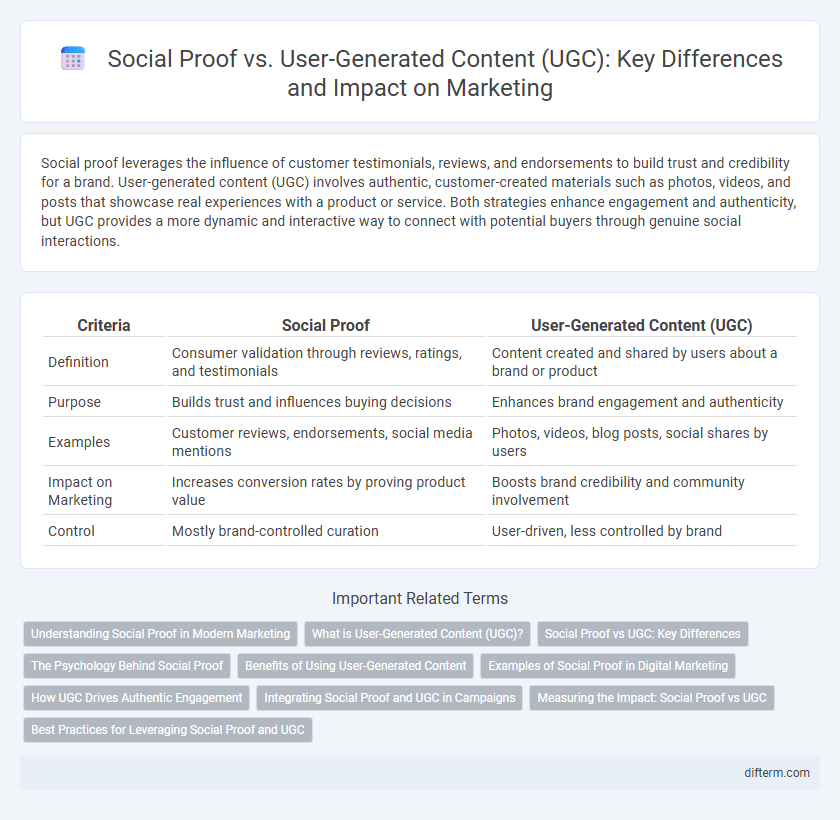Social proof leverages the influence of customer testimonials, reviews, and endorsements to build trust and credibility for a brand. User-generated content (UGC) involves authentic, customer-created materials such as photos, videos, and posts that showcase real experiences with a product or service. Both strategies enhance engagement and authenticity, but UGC provides a more dynamic and interactive way to connect with potential buyers through genuine social interactions.
Table of Comparison
| Criteria | Social Proof | User-Generated Content (UGC) |
|---|---|---|
| Definition | Consumer validation through reviews, ratings, and testimonials | Content created and shared by users about a brand or product |
| Purpose | Builds trust and influences buying decisions | Enhances brand engagement and authenticity |
| Examples | Customer reviews, endorsements, social media mentions | Photos, videos, blog posts, social shares by users |
| Impact on Marketing | Increases conversion rates by proving product value | Boosts brand credibility and community involvement |
| Control | Mostly brand-controlled curation | User-driven, less controlled by brand |
Understanding Social Proof in Modern Marketing
Social proof leverages customer reviews, testimonials, and influencer endorsements to build trust and influence purchasing decisions. Unlike user-generated content (UGC), which includes authentic customer-created posts and media, social proof specifically highlights credible validation to enhance brand reputation. Understanding the strategic use of social proof in digital marketing campaigns significantly boosts conversion rates and customer loyalty.
What is User-Generated Content (UGC)?
User-Generated Content (UGC) refers to any form of content, such as reviews, photos, videos, or testimonials, created and shared by customers or users rather than the brand itself. UGC enhances brand trust by providing authentic and relatable experiences, making marketing campaigns more credible and engaging. This type of content leverages customers' voices to drive social proof and influence potential buyers' decisions.
Social Proof vs UGC: Key Differences
Social proof leverages endorsements such as reviews, testimonials, and influencer mentions to build trust and credibility, while user-generated content (UGC) consists of authentic content created and shared by customers, like photos, videos, and posts. Social proof primarily influences purchasing decisions by showcasing third-party validation, whereas UGC drives engagement and brand loyalty through relatable and organic customer experiences. Both strategies enhance marketing effectiveness but serve distinct roles in consumer persuasion and brand storytelling.
The Psychology Behind Social Proof
Social proof leverages the human tendency to follow the actions and opinions of others to validate decision-making, tapping into innate social validation and conformity principles. User-generated content (UGC) amplifies this effect by providing authentic, relatable examples of product use from real customers, increasing trust and credibility. Psychological drivers such as social identity, the bandwagon effect, and fear of missing out (FOMO) reinforce the impact of social proof in marketing strategies.
Benefits of Using User-Generated Content
User-generated content (UGC) enhances brand authenticity by showcasing genuine customer experiences, which significantly boosts trust and credibility in marketing campaigns. Leveraging UGC increases engagement rates by encouraging active participation from the audience, leading to higher conversion rates and customer loyalty. Brands benefit from cost-effective content creation, as UGC reduces the need for expensive production while expanding reach through organic sharing.
Examples of Social Proof in Digital Marketing
Customer testimonials showcased on landing pages enhance trust by providing authentic user experiences. Influencer endorsements on social media platforms leverage audience credibility to boost brand awareness and conversion rates. Ratings and reviews on e-commerce websites serve as decisive factors influencing purchase decisions and improving SEO rankings.
How UGC Drives Authentic Engagement
User-generated content (UGC) drives authentic engagement by showcasing real customer experiences that build trust and credibility more effectively than traditional social proof. Brands leveraging UGC benefit from increased interaction rates, as consumers perceive content from peers as more relatable and genuine. Incorporating UGC in marketing strategies enhances organic reach and fosters a loyal community, reinforcing brand authenticity.
Integrating Social Proof and UGC in Campaigns
Integrating social proof and user-generated content (UGC) in marketing campaigns enhances brand credibility by showcasing authentic customer experiences and endorsements. Leveraging testimonials, reviews, and real customer photos or videos increases trust and engagement, driving higher conversion rates. Campaigns that strategically combine social proof elements with compelling UGC foster deeper emotional connections and encourage organic sharing across social media platforms.
Measuring the Impact: Social Proof vs UGC
Measuring the impact of social proof versus user-generated content (UGC) involves analyzing key metrics such as engagement rates, conversion rates, and brand sentiment. Social proof, including testimonials and influencer endorsements, typically drives higher trust and immediate conversion by leveraging perceived authority. In contrast, UGC fosters deeper brand community involvement and long-term loyalty by showcasing authentic customer experiences, which can be quantified through shares, comments, and increased repeat purchases.
Best Practices for Leveraging Social Proof and UGC
Maximize brand credibility by showcasing authentic user-generated content alongside social proof such as reviews, testimonials, and influencer endorsements to build trust. Encourage customers to share their experiences on social media and integrate this content into marketing campaigns to enhance engagement and conversion rates. Regularly monitor and curate high-quality user-generated content to maintain authenticity and reinforce positive brand perception.
Social proof vs user-generated content (UGC) Infographic

 difterm.com
difterm.com